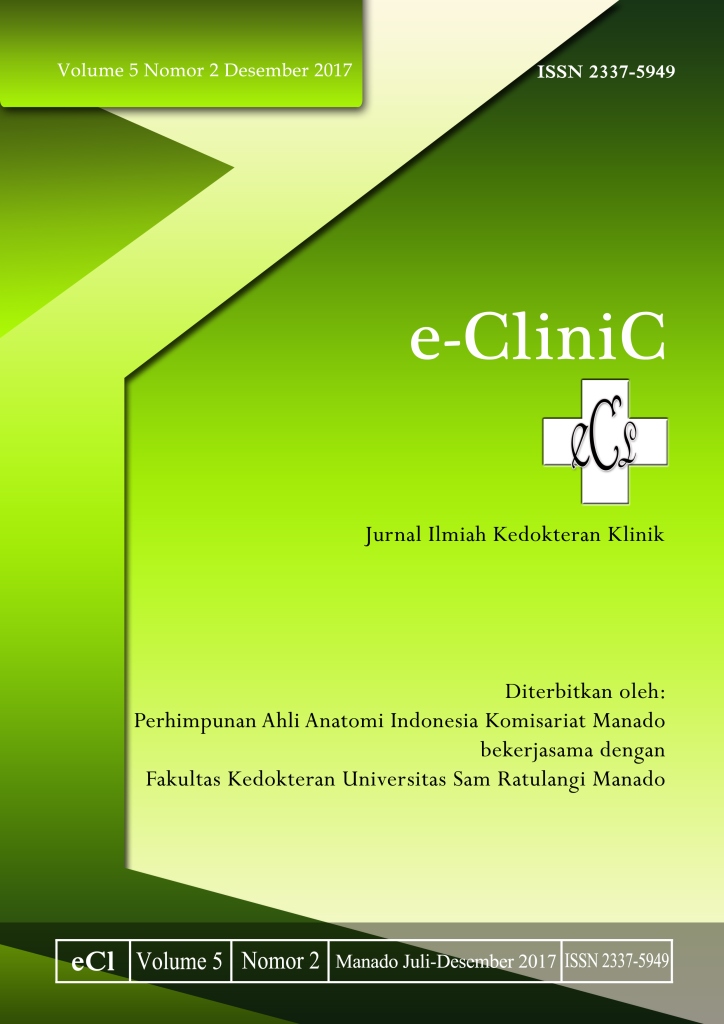Perbandingan Pemulihan Laju Jantung antara Subjek Obes Sentral Terlatih dengan yang Non-obes Sentral Tak Terlatih
DOI:
https://doi.org/10.35790/ecl.v5i2.16878Abstract
Abstract: Heart rate recovery (HRR) is a predictor of cardiovascular mortality in adult as well as a risk factor of diabetes mellitus and cardiovascular diseases. Heart rate recovery is affected by autonomic nerve system and interestingly, athletes have more effective autonomic nerve system than the non-athletes. This was an observational descriptive study with a cross-sectional design. Subjects were 15 adult trained males with central obesity and 15 untrained males without central obesity. Central obesity was determined if abdominal circumferences was above 90 cm. The treadmill test with Bruce protocol was used to evaluate the HHR at the second minute of recovery which was abnormal if the HRR below 42 times per minute. The non-tailed T test was used to determine the comparison of HRR between trained central obese and non-trained non-central obese subjects. The results showed that the 15 trained males with central obesity had average age 31.7±3.7 years and mean abdominal circumference 98.6±5.66 cm meanwhile the 15 untrained males without central obesity had mean age 29.4±6.4 years and mean abdominal circumference 80.27±7.05 cm. Mean HRR of the trained subjects was 55.6±10.6 and of the untrained subjects was 47.8 ±1.8. The non-tailed T test showed significant result in comparing the HRR between trained subjects and untrained subjects (P < 0.025). Abnormal HRR was found in 6.6% of the trained subjects and in 20% of the untrained subjects. Conclusion: Trained males with central obesity had a better HRR significantly than untrained males without central obesity; therefore, physical exercise played an important role in HRR.
Keywords: heart rate recovery (HRR), central obesity, trained
Â
Abstrak: Pemulihan laju jantung (PLJ) merupakan prediktor kematian kardiovaskular pada orang dewasa dan dipengaruhi oleh sistem saraf otonom. Uniknya, atlet atau individu yang terlatih memiliki sistem saraf otonom yang lebih efektif dibandingkan dengan yang tidak terlatih. Jenis penelitian ialah deskriptif observasional dengan desain potong lintang. Subjek penelitian terdiri dari15 pria dewasa dengan obesitas sentral yang terlatih dan 15 pria dewasa dengan non-obesitas sentral yang tidak terlatih. Subjek dinyatakan terlatih bila memenuhi rekomendasi latihan fisik menurut WHO. Obesitas sentral diukur dengan meteran pada lingkar perut bila lebih dari 90 cm. Uji latih jantung (ULJ) menggunakan treadmill dengan protokol Bruce. Pemulihan laju jantung dinilai pada menit ke-2 fase pemulihan dan dikatakan abnormal bila PLJ <42 x/menit. Perbandingan antara PLJ pada subjek obes sentral yang terlatih dengan subjek non-obes sentral yang tidak terlatih diuji dengan uji-T tidak berpasangan. Hasil penelitian mendapatkan 15 subjek pria obes sentral yang terlatih dengan rerata usia 31,7±3,7 tahun, rerata lingkar perut 98,6±5,66cm dan 15 subjek pria non-obes sentral yang tidak terlatih dengan rerata usia 29,4±6,4 tahun, rerata lingkar perut 0,27±7,05cm. Rerata PLJ pada subjek obes sentral yang terlatih 55,6±10,6, dan rerata PLJ pada non-obes sentral yang tidak terlatih 47,8±1,8. Uji-T tidak berpasangan mendapatkan hasil bermakna untuk perbandingan antara PLJ pada subjek obes sentral yang terlatih dengan subjek non-obes sentral yang tidak terlatih (p<0,025). Didapatkan nilai abnormal PLJ 6,6% pada kelompok subjek obes sentral terlatih dan 20,0% pada kelompok subjek non-obes sentral tak terlatih. Simpulan: Subjek obes sentral yang terlatih memiliki PLJ yang lebih baik dibandingkan dengan subjek non-obes sentral yang tidak terlatih secara bermakna yang menunjukkan faktor latihan fisik berperan penting terhadap PLJ.
Kata kunci: pemulihan laju jantung (PLJ), obesitas sentral, terlatih
Downloads
Published
How to Cite
Issue
Section
License
COPYRIGHT
Authors who publish with this journal agree to the following terms:
Authors hold their copyright and grant this journal the privilege of first publication, with the work simultaneously licensed under a Creative Commons Attribution License that permits others to impart the work with an acknowledgment of the work's origin and initial publication by this journal.
Authors can enter into separate or additional contractual arrangements for the non-exclusive distribution of the journal's published version of the work (for example, post it to an institutional repository or publish it in a book), with an acknowledgment of its underlying publication in this journal.
Authors are permitted and encouraged to post their work online (for example, in institutional repositories or on their website) as it can lead to productive exchanges, as well as earlier and greater citation of the published work (See The Effect of Open Access).







